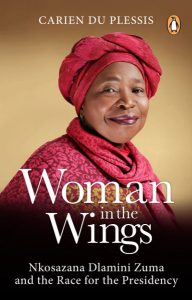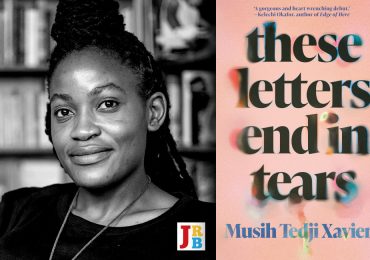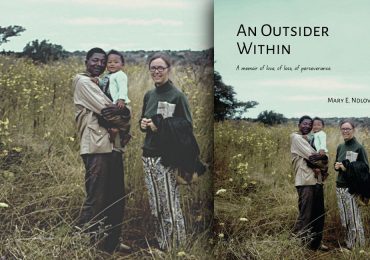Adekeye Adebajo reviews Woman in the Wings by Carien du Plessis, offering concluding reflections on Agenda 2063, Nkosazana Dlamini Zuma’s dubious fifty-year vision for the continent.
 Woman in the Wings: Nkosazana Dlamini Zuma
Woman in the Wings: Nkosazana Dlamini Zuma
Carien du Plessis
Penguin Random House South Africa, 2017
1. The biography we deserve
This is a journalist’s book, a political biography, succinct and readable, with some interesting insights into the life and times of sixty-nine-year old Nkosazana Dlamini Zuma, who has held three high-profile ministerial portfolios under the presidencies of Nelson Mandela, Thabo Mbeki, Kgalema Motlanthe and Jacob Zuma, and who has now, surprisingly, returned to the South African cabinet as a minister in the Presidency under Cyril Ramaphosa—the man she lost to in her recent quest to become president of the ANC. Woman in the Wings is not, however, the biography of Dlamini Zuma, who was also Chairperson of the African Union Commission (AUC) between 2012 and 2017, that we required—but it is, perhaps, in its South African self-centredness, the biography we deserve. Allow me to explain this thinking in the review that follows, which examines Dlamini Zuma’s formative experiences; assesses her ministerial performance between 1994 and 2012; analyses her chairing of the AUC; and offers concluding reflections on Agenda 2063, her dubious fifty-year vision for the continent.
The ANC presidential campaign of 2017 was Dlamini Zuma’s to lose, and she contrived to lose it. Having been ahead of deputy president Ramaphosa for most of the race, she ultimately misread the dramatic changes that had taken place in South Africa’s political landscape since 2012, when she left for Addis Ababa to chair the AU. She was clearly too close to her deeply unpopular ex-husband, then-president Jacob Zuma, on whose ‘Premier League’ of provincial leaders and financial patronage network she relied for her campaign. On the other hand, calling her ‘no different from Jacob Zuma … she is Jacob Zuma in a doek’, as commentator Justice Malala once did, as quoted in Woman in the Wings, is decidedly off the mark, a clearly sexist repudiation of her own identity and record.
On the hustings, Dlamini Zuma was often her own worst enemy, as when she ignored questions on why she had a presidential protection unit as a non-ministerial candidate. She simply refused to provide any answers to the media, creating the sense that she was entitled; that, and unused to accountability. Du Plessis’s book is particularly strong at exploring the dynamics at play on smaller questions like this, but the author, surprisingly, does not tackle many larger ones. For example: what of the possibility that misogyny among ANC delegates played a countervailing role against Dlamini Zuma’s candidacy—one that, along with Dlamini Zuma’s clumsy handling of day-to-day controversies, ultimately ensured that the final glass ceiling remained unshattered in South Africa? A strong woman leader, foiled again: is Dlamini Zuma South Africa’s Hillary Clinton? The comparison might have seemed apt, even before the outcome was known, but it is avoided in Woman in the Wings. (This reviewer is moved further to ask, in admittedly post-hoc fashion: How can the ANC continue to claim a non-sexist tradition when, after the votes were counted, only one of the top six positions—that of Deputy Secretary General—went to a woman?)
Dlamini Zuma’s time as Chair of the AU is at the heart of this biography, comprising a large percentage of the book’s pages. Disappointingly, these sections fail to provide any real sense of the significance and consequences of her four-year tenure there. The author complains about the failure of political associates of Dlamini Zuma to talk to her, but she could have cast her net further and canvassed AU sources more widely, instead of relying heavily, in the wake of lack of access, on South African analysts, many with no sound record on African and AU issues. There is also an over-reliance on South African media outlets like The Star, Business Day, City Press, the Cape Times and the Sunday Times, which have a chequered record when it comes to coverage of continental issues. Although Du Plessis attempts to delineate Dlamini Zuma’s record on something like objective terms, the impression left is, at times, of a simple aggregation of clippings and soundbites.
2. From Adams College to exile and back
That said, Du Plessis has some success drawing out the paradoxes of her subject: a woman with rural roots who led a continental body; a gender activist who married a polygamist; and a popular leader with a problematic lack of charisma. The book’s early chapters reveal interesting insights into Dlamini Zuma’s childhood and ideological awakening. Her home, something of an apartheid-era rural idyll, set among KwaZulu-Natal’s rolling hills, wooded forests, and snow-covered Drakensberg mountains, was dominated by her schoolteacher father, Willibrod Dlamini, and her strict, homemaker mother, Rose. Dlamini Zuma, the eldest of eight children, attended the famous mission school, Adams College, which had also trained ANC stalwarts Albert Lutuli and John Dube, as well as the former presidents of Uganda and Botswana, Milton Obote and Seretse Khama.
Adams College was where Dlamini Zuma’s political consciousness was first awakened, and where she assumed her first leadership roles. She wanted to be a lawyer, but acceded to her father’s demand to study medicine, first graduating with a degree in Zoology from the University of Zululand, before pursuing her medical studies at the University of Natal. She became vice-president of Steve Biko’s South African Students’ Organisation before going into exile in Swaziland, where she met both Jacob Zuma and Thabo Mbeki. Steeped at first in the ideology of Biko’s Black Consciousness Movement, rather than in the ANC’s non-racialism, she envisioned a radical restructuring of a capitalist, imperialist South African economy, before settling into more mainstream ANC policies, and becoming sceptical about the efficacy of Black Consciousness in liberating South Africa. Dlamini Zuma does not seem to have carried her earlier youthful radicalism into government, and only belatedly returned to it, via the rather unconvincing mantra of ‘radical economic transformation’ that she espoused—along with a host of people in the pro-Zuma camp—during her 2017 campaign.
She completed her medical studies at Bristol University in England, where she headed the ANC’s youth section, and travelled tirelessly across Europe spreading the party’s liberation gospel. Dlamini Zuma returned to Swaziland to work in a government hospital, continuing her ANC activities, and there married Jacob Zuma (who was already married to two other women) in 1982—but the book does not provide much detail on the courtship and relationship, though we are told that the lobola was eleven head of cattle. The couple had four daughters together, but were often apart. Dlamini Zuma completed a post-graduate diploma at the University of Liverpool, and thereafter worked in a British hospital for two years. She went to the ANC’s headquarters-in-exile in the Zambian capital of Lusaka before returning home after Nelson Mandela’s release from jail in February, 1990. Her marriage to Zuma ended in divorce in 1998.
3. Locked in the Cabinet
As Mandela’s health minister between 1994 and 1999, Dlamini Zuma was often portrayed in the media as ‘Godzuma’: unsmiling, arrogant and brusque. She delivered free health care to poor women and children, however; faced down South Africa’s powerful tobacco lobby in banning smoking in public places; brought hundreds of Cuban doctors to South Africa, in both a show of solidarity with a country that had played a critical role in the anti-apartheid struggle and as a pragmatic means of filling a skills gap; and fought avaricious pharmaceutical companies which were blocking the purchase of cheap antiretroviral treatments to HIV/Aids sufferers. But where there were ups, there were also downs: Du Plessis records how Dlamini Zuma became embroiled in the 1996 Sarafina II scandal, which saw R14 million from her budget allocated to an anti-Aids play by her friend, Mbongeni Ngema. Perhaps this was where the popular conceptions about her lack of accountability and sense of entitlement began to take root, as Dlamini Zuma toughed out the situation and was fortunate to have been protected by president Mandela. She was also involved in the Virodene scandal, when she and deputy president Mbeki pushed an untested toxic industrial solvent as an anti-Aids drug in opposition to the advice of the country’s Medicines Control Council. Dlamini Zuma, to her credit, later challenged Mbeki’s views on HIV/Aids, which led him publicly to withdraw from debate on the issue.
As foreign minister between 1999 and 2009, Dlamini Zuma was active in such diplomatic theatres as Zimbabwe and the Democratic Republic of the Congo. Tony Leon, an opposition leader, had quipped that her appointment was like ‘sending the bull into the china shop’, and Du Plessis describes a ‘brusque and abrasive management style’. However, the author fails to take into account how much Dlamini Zuma’s influence was overshadowed by Mbeki’s: he personally mediated the DRC peace process; and he personally led the Zimbabwe negotiations, rather than delegate them to Dlamini Zuma. The author criticises her for promoting ‘quiet diplomacy’ towards Robert Mugabe’s regime in Harare, when it was, in fact, Mbeki-led ANC and government policy. Mbeki was, in a sense, effectively his own foreign minister on key issues, with Dlamini Zuma as implementer rather than initiator. (Du Plessis is on more solid ground in criticising Dlamini Zuma’s blocking of Tibetan spiritual leader and Nobel Peace Prize laureate The Dalai Lama’s visit to South Africa in 2009.)
Dlamini Zuma would turn down Mbeki’s offer to be his deputy president, after he fired her ex-husband in 2005, following pleas from the four Zuma daughters. In her role as Minister of Home Affairs between 2009 and 2012, meanwhile, she comes in for praise, in Woman in the Wings, for her energy, efficiency, and empathy. In a repeat of the South-South solidarity she showed while health minister, she brought Cuban immigration experts in to help train local officials. Unlike many senior South African government officials (including Mbeki himself), the Western-trained Dlamini Zuma did not automatically turn to the West for models for South Africa. And so, without wanting to suffer from an over-reliance on the often superficial yearly ministerial ratings of the Mail and Guardian—which this book does—it nonetheless seems a fair conclusion that Dlamini Zuma has been one of democratic South Africa’s most effective cabinet mandarins.
4. Chair of the AU Commission: A triumph of style over substance
It is also fair to say that this effectiveness on South African soil did not transplant terribly well in Ethiopia. The core of Woman in the Wings—Dlamini Zuma’s time as Chairperson of the AU Commission—is, in many ways, its least compelling component. The author posits that Dlamini Zuma was effectively ‘deployed’ to the AU by the ANC in order to limit her local political potential—effectively taking her out of the local politics game. If true, South Africa thus, in the process, broke the continental body’s unwritten rule that no citizen of a so-called ‘big country’ should occupy the position of chairperson, merely for reasons of local politics—an extremely shortsighted act. The book’s lack of nuance on the AU as an institution is demonstrated repeatedly, meanwhile: for example, in its blaming of Gabonese AU Commission chair, Jean Ping, for failures in Côte d’Ivoire, Libya and Egypt, rather than examining how local, regional and global power politics intersect in ways that, like at the United Nations, render the AU’s head more of a secretary than a general. The author’s frequent criticisms of what she sees as an anachronistic South African ‘anti-Western liberation movement mentality’ shows a further failure to understand the widespread perception of South Africa as a ‘Western Trojan horse’ in many parts of Africa, due to its white-dominated economy, academy and civil society. Her criticism of Dlamini Zuma finding the French ‘unnecessarily meddlesome’ shows a lack of understanding of the ‘pyromaniac fireman’ role that the Gallic nation has historically played in theatres like Togo, the DRC, Chad and the Central African Republic—and continues to play, today, in the Sahel—as well as its well documented, shameful actions during the Rwandan genocide, when it helped to train and arm many of the country’s génocidaires.
Du Plessis also does not go into much detail on one of the most persistent criticisms of Dlamini Zuma’s tenure at the AU: that she used South African nationals as key advisers and as her main security detail in Addis Ababa, which only reinforced perceptions of South Africa as an insular nation. In blaming Dlamini Zuma for not doing more to halt conflicts in South Sudan, Libya, Mali, Burundi and the CAR, the author again demonstrates a lack of understanding of the local, regional, and global dynamics that underwrote these conflicts; and she erroneously blames a decision by African countries to withdraw from the Hague-based International Criminal Court—which was subsequently not widely implemented—on the Dlamini Zuma-led AU, rather than, more accurately, on the agitations of member states such as Kenya, Uganda, Sudan and Gambia.
Du Plessis hits the mark, though, in highlighting Dlamini Zuma’s championing of gender issues, her most consistent priority during her four-year tenure. Dlamini Zuma, to be sure, was quite conscious of her trailblazing role as the first-ever female head of a continental body and the responsibilities that went with playing this pioneering role. But her biographer fails to give more credit to Dlamini Zuma’s leading the drive to suspend Egypt from the AU after General Abdel Fattah el-Sisi’s military coup in 2013: it took real political courage to push an effort against one of the five biggest (assessed) financial contributors to Dlamini Zuma’s own organisation’s budget. Du Plessis is on firmer ground in criticising Dlamini Zuma’s lethargic response—particularly as a former health practitioner—to the Ebola crisis in Liberia, Sierra Leone and Guinea, only belatedly visiting the three countries after much criticism. But meanwhile she also quotes, approvingly, the highly personalised, caustic critique of Nigerian human rights activist Chidi Odinkalu, that Dlamini Zuma’s tenure enabled the spread of autocracy on the continent: a totally jaundiced and misguided view, more shrill than substantive.
Add to this hodgepodge a final misstep: Woman in the Wings is far too kind to Dlamini Zuma’s 2013 Agenda 2063, portraying the quixotic plan to develop and modernise Africa as the continent’s first-ever navigable map to prosperity. The main problem with a fifty-year plan, of course, is that none of its authors will be alive to be held accountable for its inevitable failure. More than any other initiative, this plan represents the triumph of style over substance that rests at the heart of Dlamini Zuma’s AU Commission—it is an alchemic text whose euphoric ideas include: increasing intra-African trade from twelve per cent in 2013 to fifty per cent by 2045; making corruption and impunity a thing of the past; rendering government institutions developmental, democratic, and accountable; silencing all the guns by 2020; and ending terrorism, gender-based violence, illicit trade in small arms, and drug and human trafficking. I suppose all peoples need platonic ideals to aim for, but this moment of wishful thinking does not tally with the daily realities that Dlamini Zuma would have been exposed to in her role.
5. Agenda 2063 and Nkrumah’s ghost
Setting aside Du Plessis’s book for a moment—or, perhaps, fleshing out a counter-narrative to it that is less parochial and more Pan-African—although Nkosazana Dlamini Zuma sought to provide visionary leadership to the AU through the text of Agenda 2063, it is worth asking whether she might not have been stalked by the ghost of Ghana’s founding leader, Kwame Nkrumah, while composing it. The lessons of his failed vision, in the nineteen-sixties, of a common African currency, government, and military command, do not appear to have been learned by the likes of Dlamini Zuma. It is not clear that she took into account the political and socioeconomic constraints of her own era in outlining her fifty-year plan for her continent—a troubling observation to make, given how close she was to on-the-ground events.
For while she had successes as AUC Chair—under her leadership, the fifteen-member AU Peace and Security Council continued to be active in African conflicts; gender issues were prioritised; and there were some administrative and management reforms—the Commission continues to struggle, after fifteen years, to establish its independence; and it still lacks the ability to take real initiative on behalf of its fifty-five members. The organisation’s New Partnership for Africa’s Development (Nepad) lacks the resources and capacity to undertake significant work; the Pan-African Parliament (PAP) largely remains a talking shop; the Economic, Social and Cultural Council (ECOSOCC) has failed to provide genuine civil society participation in the AU’s institutions. In short, despite Dlamini Zuma’s efforts, the AU was not transformed in any fundamental way during her four years, and Agenda 2063 will surely be remembered as the most obvious symbol of the only brand of diplomacy currently viable at the AU: one of marabouts, fetishes, and incantations, and not likely to get Africa anywhere in a hurry.
In seeking, through Agenda 2063, to legislate what is desirable into existence—as if by magic—and via the piecemeal approach of employing empty, high sounding slogans that are more symbolic than substantive, Dlamini Zuma’s efforts are not unlike Du Plessis’s, whose reconstruction of her subject’s life ultimately lacks the requisite density. Indeed, the fate of Woman in the Wings is likely to be similar to that of Agenda 2063; both serve up distinctly unsatisfying—and sometimes unrecognisable—portraits, and both are accordingly headed for the footnotes. Another, more comprehensive and nuanced biography of Dlamini Zuma is doubtless waiting in time’s wings, but whether it will see the light of day is as open a question as whether South Africa will ever have a woman president; or Africa a credible single voice.
- Professor Adekeye Adebajo is the Director of the Institute for Pan-African Thought and Conversation (IPATC) at the University of Johannesburg in South Africa. He is the author of The Eagle and The Springbok: Essays on Nigeria and South Africa (2017); and Thabo Mbeki: Africa’s Philosopher-King (2016). He obtained his doctorate from Oxford University where he studied as a Rhodes Scholar.






Thanks for good article.